(Updated January 2023 with details on how to do this with SEMRush in addition to Ahrefs; updated November 2022 with more about lead management; updated August 2022 with a new infographic; updated February 2022 with additions on finding affiliates through Amazon)

Affiliate marketers promote your products cause it earns them a commission. But how do you get more product reviews from affiliate marketers?
If you want to drive more traffic and sales to your business, one way to do that is to leverage affiliates and partnerships. Affiliate sites that already have a lot of traffic can send potential customers your way, in exchange for a commission on sales they send to you.
But, the typical process that other blogs recommend for finding affiliates, frankly, isn’t great.
Without naming names, a lot of articles on “how to find affiliates” or “how to recruit affiliates” are written by affiliate networks. So, they have a particular perspective on things. Their advice tends to boil down to telling you to sign up for their affiliate networks, add your products to their affiliate marketplace, and allow affiliates to discover and share your products.
And that all sounds great, if it would magically get people to sign up…
But it doesn’t really happen that way.
The drawback to this strategy is – it relies on you posting your products to a particular affiliate network, and hoping that other affiliate marketers find you.
If you are a product or business that people haven’t heard of, it’s not going to get all that many sign-ups.
So, I have a better strategy, backed up by some data.
Within one month of doing this strategy, I found:
437 relevant affiliates to connect with
66 conversations
31 affiliates signing up

How did I do it?
In this article, I’ll break it all down.
Also, we got some extras else to share. First – we created a video breaking down this strategy and walking you through our process:
And next, there’s an infographic at the bottom of this article that lays out the step-by-step process you can repeat yourself if you want to find and recruit affiliates to promote your products.
First, What’s an Affiliate?
So, if you are not familiar with affiliate marketing, here is a summary:
An affiliate marketer is someone who has a website that exists for the main purpose of recommending products. On the website, they will link to those products in their articles. When you click on a link from their article and then buy that product, the affiliate marketer earns a commission.
Affiliate blogs are in the business of writing articles that link to products that earn them a commission and driving traffic to those articles so they can get more commissions.
Basically, they write blog posts / articles designed to sell products and bring in affiliate revenue as their income source from their content, but they typically don’t make a product themselves.
Affiliates commonly link to physical products on e-commerce websites like Amazon and other retailers, as well as digital products, SaaS businesses / software, and other services.
Often, affiliates will review products and give their feedback, building trust with their audience, so that any products they recommend, will be more likely to generate some paying customers. A well-known affiliate marketer is an influencer in their niche / target industries, viewed as industry experts, and can encourage customers to buy products.
Finding, connecting with, and recruiting potential affiliate partners can help you leverage their audience and traffic, and bring in more sales to your business.
So, now that we know how affiliates work, let’s talk about how we can find relevant influential affiliates and connect with them.
How to Find Affiliates – Steps to Our Strategy
Our process is going to involve:
1. Finding relevant affiliates
2. Reaching out to recruit these affiliates via email
3. Signing them up
4. Managing your affiliate outreach campaigns
Key to this strategy is going to be that we are going to find people who are affiliates of relevant products to yours. We are going to pitch them along the lines of:
“Hey, I saw that you are an affiliate of Brand X. Since you’re referring their product, I thought you might be interested in being an affiliate for Brand Y. We offer Z% commissions on all sales and…“
Why this Strategy to Find New Affiliates Works
You might be wondering, “I don’t get it. Why is this strategy more effective than just going to affiliate directories, which is probably a lot quicker.”
Yes, signing up for an affiliate directory is quick and easy to do.
But, like I mentioned earlier – the affiliates you want to recruit may not see you. They might not be members of that particular affiliate program. They may also not be actively looking for products like yours. And the people who do find your product and sign up as an affiliate might not have relevant content already on their website that can send traffic and sign-ups your way.
This strategy works because:
1. These affiliates we are targeting have demonstrated interest in your product area with a target audience relevant to yours
2. These affiliates already have traffic, content, and an audience that is relevant to your business; they are not affiliate newbies with little traffic
3. It’s minimal effort for these affiliates – they can easily sign up for affiliate program, drop in an affiliate link to an existing article of theirs, and start sending new customers your way relatively quickly
What You Need To Get Started Finding Affiliates
Now, let’s talk about the tools you will need and why these tools.
To find new affiliates for your business, you will need:
1. Keyword research software (I recommend Ahrefs and will be using it in this example, but you could also use something like SEMRush)
2. Contact-finding and email outreach software (I recommend Postaga)
3. A spreadsheet or CRM for managing conversation (Postaga has one built-in, but you might want another tool like a Google Sheet or CRM integrated into your email marketing, like ActiveCampaign)
We are going to use the keyword research tool to find websites that are affiliates for your competitors / other products in your industry / niche.
We are going to use the contact-finding and email outreach software to find contact people and email addresses for those websites, and pitch them to be affiliates for your product.
And we are going to use Postaga’s CRM to keep track of and manage your conversations with these affiliates.
Next up, let’s see how we can find affiliates for your business.
How to Find Affiliates for Your Brand or Business
The first thing you will need to do is know some of the other companies in your space.
I am betting that you already know many companies in your space though.
Make a list of them.
Let’s take an example: Say that your company makes a project management software tool.
Your direct competitors would be companies like:
- Trello
- Asana
- Basecamp
You would definitely be interested in connecting with their affiliates.
But, we want to widen our reach, so let’s not just reach out to affiliates of direct competitors. Let’s also find adjacent companies.
In this example of project management software, you might also be interested in other business productivity tools. So, you would do some Googling and add to your list software like:
- Slack
- Evernote
- Fleep
Great. Now you have a list of a bunch of relevant companies.
Now, it’s time to get to finding their affiliates.
In this example, I am use Ahrefs.
(For a look at this with SEMRush, check our other section here)
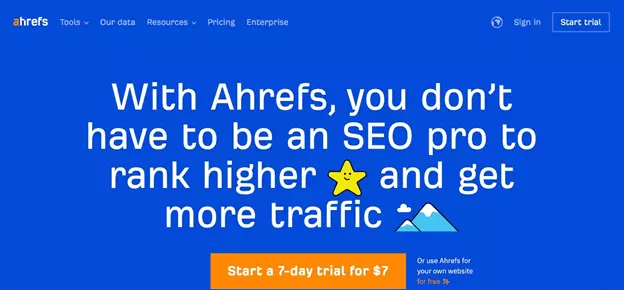
Ahrefs is not a free tool, unfortunately, but I have found it incredibly useful for my business. In particular, it’s very helpful with doing research for our content marketing and SEO.
If you don’t have an account, they offer a 7-day trial for $7 (you might be wondering, but this is not an affiliate link – I genuinely like, use, and recommend this product).
Once I log into my Ahrefs account, I will go to the Site Explorer tool.
Here, I can enter in the domain of one of the companies.

In this example, I am going to go with Asana.
Then, Ahrefs will show me a page with a ton of information about that domain.
Next, I will go to the Backlinks tab.
In this tab, I can see all of the websites that link to Asana. From here, we will want to find the affiliates of Asana.
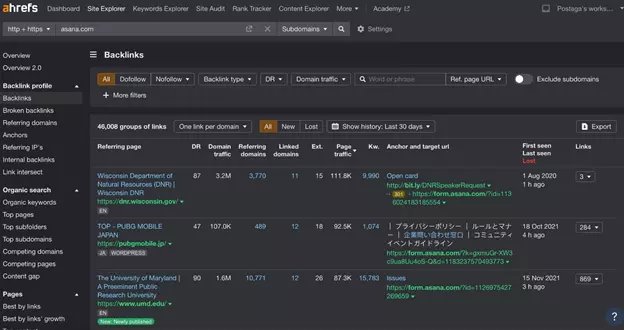
How can we do this?
Thankfully, with all of the affiliate programs out there – most affiliate links follow a very similar construction to each other.
As an example, there is an affiliate program called First Promoter. Their affiliate links tend to be something like “[your-website]/?fp_ref=[affiliate-id]”
So, we are going to “guess” at different affiliate programs until we find the right one. And there are a few tricks to help make this quick that I am going to share.
First, on this page, set the dropdown that says “Ref. page URL” to “Target URL”.
Then, add a “?” in the search box and click search.
This may result in a bunch of random backlinks showing, but you might get lucky and find an affiliate link.
Some other ideas to try for search terms:
?ref=
?gspk
utm_source=partnerstack
?fpr
Grsm.io
?fp_ref=
?
?fp_ref
?via
?deal
?_from
?_by
?_get
?_go
$_r_
Ah ha! Found it.
For Asana, “gspk” worked
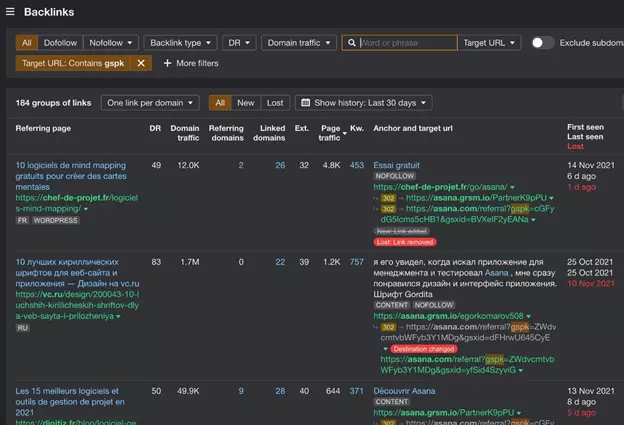
Every site that shows up in this list is either currently, or has ever been, an affiliate of Asana.
Awesome!
Now we have a list of affiliate
So, let’s export this list into a CSV file. Go to the top-right part of the page and click Export.
We will export it to a CSV file.
Now let’s take a look at it…
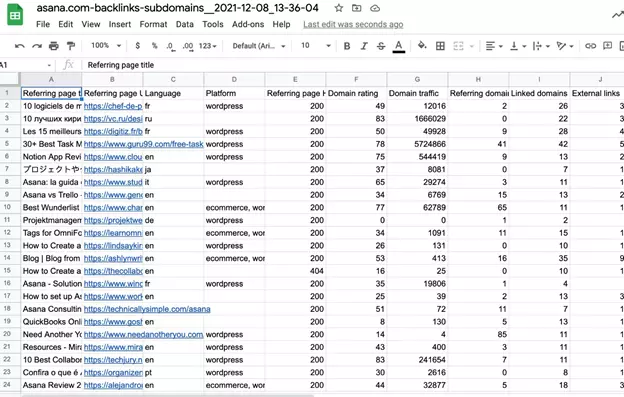
Awesome. And if I want, I can filter out some of these or remove them.
But, now I have a list of Asana affiliates.
Next, it’s time for us to reach out to recruit them! But first, a quick word about affiliates for ecommerce and physical products…
Side Note: Finding Affiliates for Products / Ecommerce
If you are in the ecommerce space, you probably want to find and recruit affiliates who are pitching competitors’ products. Besides analyzing competitors’ websites, you can also look at ecommerce platforms like Amazon, to see who is linking to competitors’ product pages.
A lot of affiliate marketers use the Amazon Affiliates program to send their traffic to Amazon to buy products and send them commissions.
But, there are some drawbacks for the affiliates (which can work to your advantage). Mainly – Amazon has low commission rates.
So, your angle when pitching affiliates can be, “Hey, I saw you are an affiliate of X product on Amazon. If you are interested, you can make up to 20% commission for our product, and we can potentially provide some additional commission tiers as well depending on how much business you refer.”
For affiliate marketers – this can be a very compelling pitch.
So, what you can do, is go to an Amazon product page for a competitor’s product, throw it into Ahrefs, grab its backlink profile, and now you have a list of websites that is sending traffic to your competitor’s product page in Amazon.
Reach out to them, and pitch them to join your affiliate program where they can make more money!
Next – let’s talk about how you can reach out to affiliates.
How to Reach Out To Recruit Affiliates
For this next step, we are going to need software that can help us find the right contact people at these websites, get their working email addresses, and build and send them personalized pitch email sequences.
For this, I use Postaga. It’s an all-in-one tool to help with email outreach. It can help you find the right people in the right departments, get their email address, and send them personalized pitches.
Postaga also has a 14-day free trial.
In my Postaga account, I am going to go to the campaign screen to create a new outreach campaign.
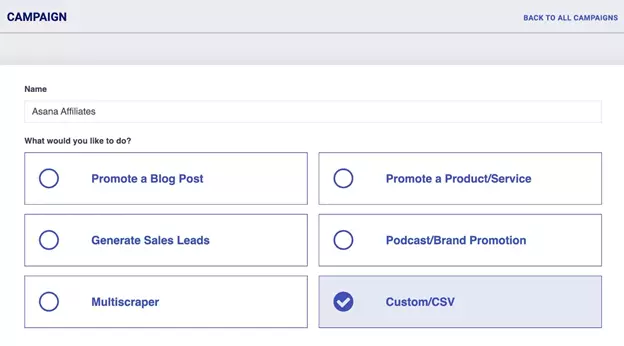
I am going to select the Custom / CSV item, and then in the next section, choose CSV.
Then, in the next section, you can upload your CSV file.
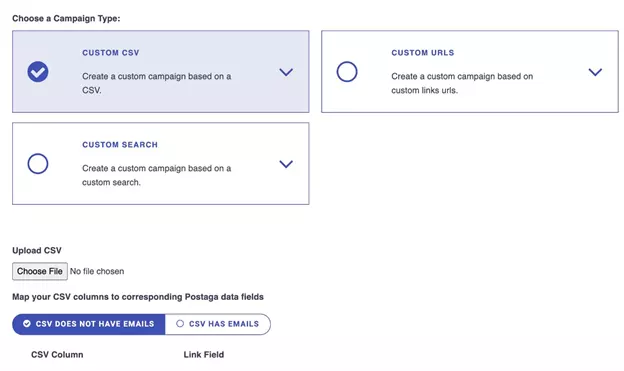
Now, it’s going to ask you to map these fields from your spreadsheet. Really, the only one you need is the “Referring Page URL” field, and map that in the drop-down to “URL”.
Then, you can scroll down and click the Map… button. And in the next prompt, select the option to “Enrich Link URLs”.
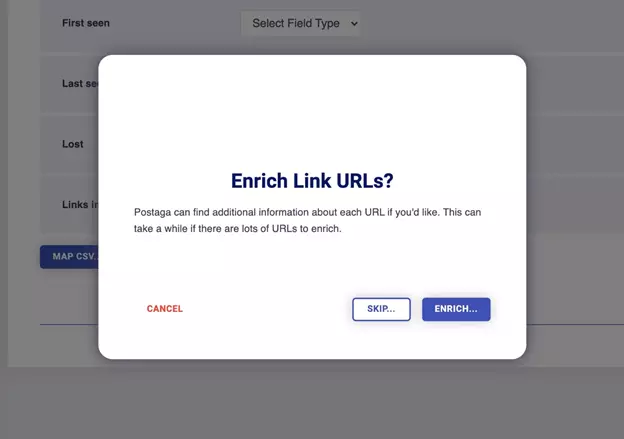
Now, Postaga is going to find the right contact people at these companies for you.
What’s happening now is that Postaga is looking for contact people at each of these companies, so you can connect with them, rather than a generic “info@” or “contact@” inbox.
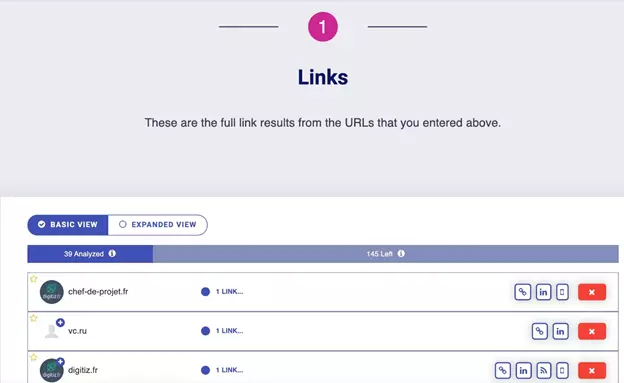
For each of the contacts, you can select a different target contact if you want, or you can keep them as-is.
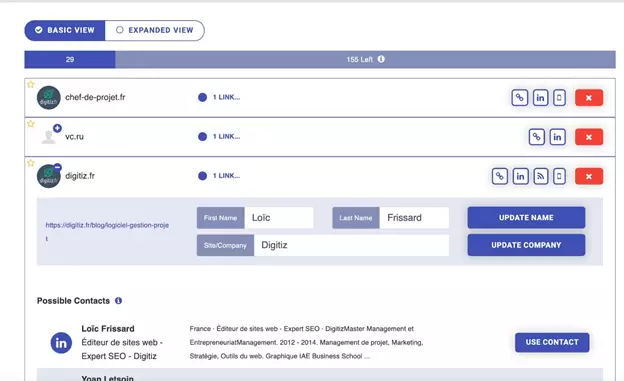
When you are all done and the target contacts are chosen, the next step is to find and verify their email addresses and get their contact details.
For each of these domains, Postaga is going to search for, and then verify, working email addresses. If Postaga can, it will find an email for your target contacts. If your specific contact cannot be found, Postaga has methods for finding other contacts.
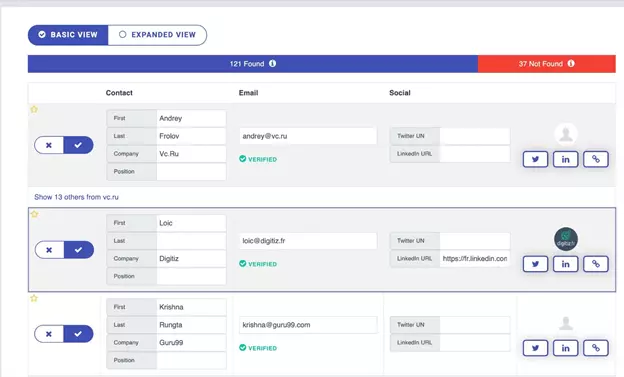
Next up, it’s time to pitch them to sign up as affiliates for your product.
In the next step in Postaga, we will choose our email sequence.
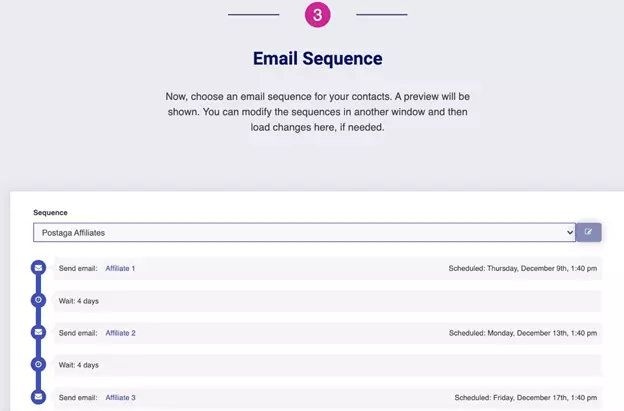
Postaga comes with some email sequences built-in for you to get started with. In addition, there is an email template library of emails you can choose from to add to your account.
There are a few email templates related to affiliates that I would recommend checking out, this way you don’t need to start from scratch.
But you can always craft and add your own from scratch with catchy subject lines and a personalized email body.
The basic pitch is:
Hey {first_name},
I came across an article of yours, {link_url}, and saw that you are an affiliate for {competitor}.
Since you are an affiliate of theirs, I thought you might be interested in being an affiliate for another product in the space, Brand X.
Brand X is a project management tool made for maximum productivity.
We also offer 25% recurring affiliate commissions.
What do you think?
Best regards,
{your_name}
I have found this pitch successful because it is very direct, has a clear ask, and we’re targeting the right people who would be interested in our product.
In Postaga, after I choose my email sequence, there’s a Spreadsheet View, so I can make sure that I edit all the right fields to personalize my emails, and don’t forget anything.
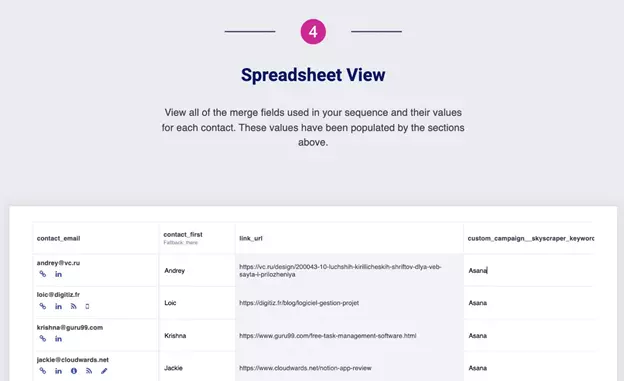
Next up is an Email Preview stage, which lets me see any of the emails for the contacts. I can also go into an individual email if I want to, and personalize it further for that recipient.
Afterwards, it’s time to send these outreach pitches!
And then, we wait for our responses.
Signing Up New Affiliates
So, what’s next?
You will get some replies.
They will fall into one of these categories:
- I’d like to learn more, where can I sign up?
- I only do paid sponsorships – do you have a budget?
- No thanks
For the “no thanks” group, we will just remove them from the last and blacklist them, so we don’t reach out to them ever again.
For the ones wanting to learn more, now we have a conversation going!
I would recommend having some assets and things ready to go. In particular:
- An affiliate signup page
- A landing page
- Media assets that your affiliates can use in their content (e.g. screenshots, text descriptions of your product and features, so it can be super easy for them to create new content featuring your product)
For the paid sponsor replies, that one will be up to you.
To manage all of these correspondence, you will need a CRM.
Postaga’s built-in CRM lets you manage the replies from your outreach campaigns, categorize them, and know which of them needs your attention.
And that is basically it.
This process is very easily repeatable. So, for each of the companies in your list of competitors / related businesses, you can find their affiliates, build and send outreach emails to pitch them to join your affiliate program and mention your product.
The CRM – A Difference-Maker for Recruiting Affiliates
One thing worth mentioning here is that while you will have some affiliates who get your pitch and sign up, others will need some hand-holding.
Like I mentioned before, they will have questions. They might want product samples or a demo.
And after you send them a sample or give them a demo, it’s still up to you to check in with them, follow up, ensuring that they do sign up for your affiliate program, and promote you to their audiences.
Using your CRM, have a regular cadence for checking in with your new affiliates to see where they’re at, if they have any questions on the product, and if they need anything else to start promoting you to their audiences.
This will help you get the most out of your affiliate recruiting.
Show these new affiliates that you are invested in them, and they will prioritize promoting your brand.
How to Find Affiliates Infographic
To help break this whole process down simply, we put together the following infographic that lists out the steps to finding affiliates one by one. This infographic touches on:
- What tools you need
- How to build your prospect list
- How to find good affiliates for your business
- Finding those affiliates’ contact details and pitching them to join your affiliate program
Check it out below, and also feel free to use the embed code below the infographic to add it to your own website!

Embed and Share this Infographic
You can add this infographic to your own blog article or webpage by copying the HTML embed code below and adding it to your webpage.
Bonus – Finding Affiliates with SEMRush
New update for 2023 – how to find affiliates using SEMRush.
This process is similar to how we do it with Ahrefs, but, the main difference is that the filtering is going to be done entirely within the exported CSV spreadsheet (because SEMRush does not have the ability to filter by “target URL” in the app itself).
So, using Asana again as our example, find it in Semrush.
Go to the Backlinks page.
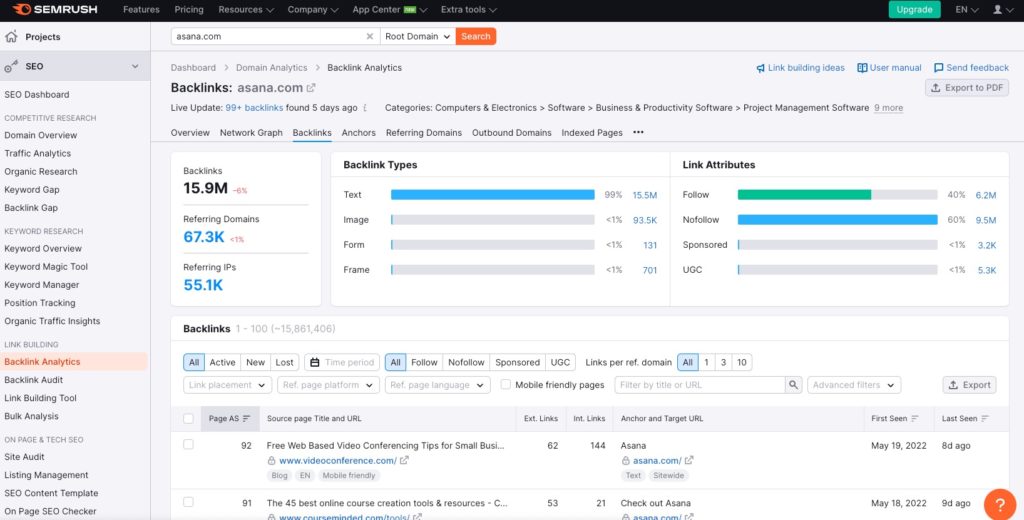
Next, you can choose to filter if you want by Active backlinks. Then, click the Export button, and export to a CSV format (you have the option of Excel or CSV).
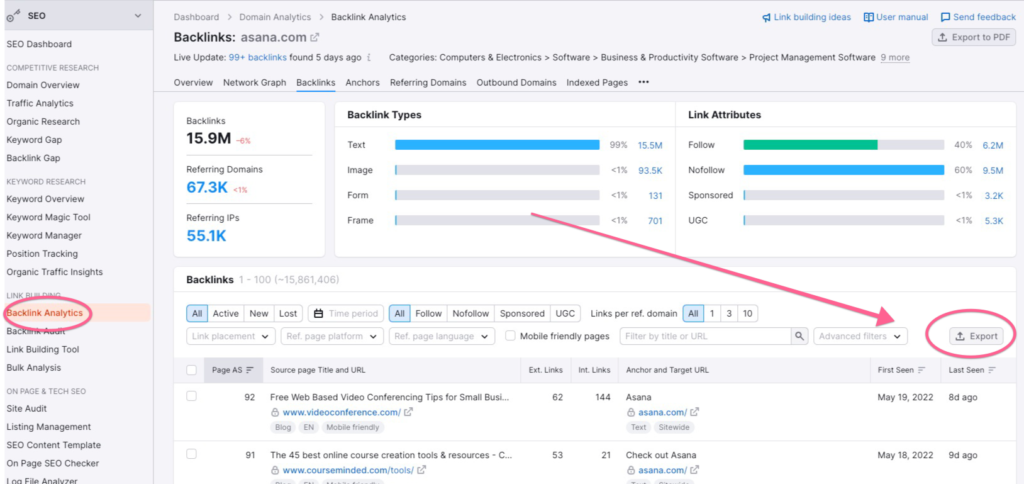
Then, open the CSV file in your favorite spreadsheet editing software (Excel, Google Sheets, etc.).
Now, you can start finding (using ctrl+f or cmd-f or the find function in your spreadsheet software) and going through our list of affiliate link url parameters (e.g. “?ref=” “?=gspk” “?fpr” etc.).
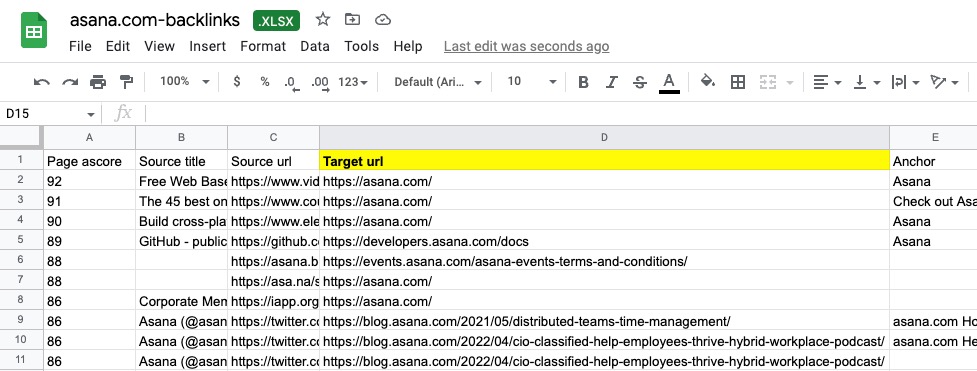
Note: It is not a guarantee that every site or brand has an affiliate program. So, you may not come up with anything for a given domain.
Once you have a hit and have found the affiliate link construction, let’s clean up this spreadsheet to remove everything else. You can now filter the spreadsheet by the Target URL column for URLs that contain your affiliate link text, then, copy/paste those rows into a brand new spreadsheet, or, just delete everything else.
When you’re done with that, you are left with a spreadsheet that contains a list of all the affiliate links of the particular website, and you can move on to finding contacts and reaching out to them!
FAQs
Next up, some FAQs all about finding affiliate marketers and getting them to sell your product.
How can I identify affiliate sites?
There are a few ways to find affiliate sites. But, the most relevant way for you to find affiliate websites is to use our Ahrefs research tools to find websites that are affiliates of products in your industry / niche and reach out to them.
What is a list of affiliate networks?
There are many different affiliate marketing programs where brands can sign up. The most popular ones are CJ (Commission Junction); ShareASale; ClickBank; Amazon Associates; eBay Partner Network; Rakuten; FlexOffers; 1win; Shopify
How can I get affiliates to sell my product?
To get affiliates to sell your product, you need to: 1) find affiliates, bloggers, or influencer marketers interested in your niche / industry; and 2) have a good offer. Your offer should be a commission rate that is competitive for your space.
What about Amazon affiliates?
Yes – you can easily find who is an affiliate through Amazon of specific products. In Amazon, go to a product page whose affiliates you want to target, then take that URL into your research software (e.g. Ahrefs), look at the backlink profile, and you can then see all the websites that link to that product page. Most all of them will be affiliate links. You can export that list to a CSV, and then reach out to those sites to become affiliates of your products.
What is a niche blogger?
A niche blogger is basically a type of affiliate marketer – someone who blogs about a specific topic area, and has affiliate links on their blog to sell products to potential customers. Niche bloggers are great potential partners since they can specialize in your industry.
What should our commission structure be?
If you are a software product, a recurring commission works best and is most appealing. 20% is standard. Higher than that, and you will stand out. Also, you might want to have commission tiers – where affiliates can earn higher commissions if they send more customers your way, to incentivize them.
What are the typical conversion rates in these affiliate channels?
Every affiliate site is different though. Thankfully, with most affiliate platforms, you will be able to evaluate your traffic sources and marketing channels, see which sites are driving you traffic, and see what your conversion rates are by channel and traffic source.
Which affiliate marketing program should I sign up for?
There are many different affiliate referral programs out there. Many of them have established affiliate marketplaces
What is a referral program vs. an affiliate program?
They are often used interchangeably, but sometimes they are different. Referral programs are usually associated with getting your brand’s existing customers to send new customers your way, often via email or social links.
How is influencer marketing different from affiliate marketing?
Influencer marketing leverages getting people with large followings on social media platforms to endorse your product, in exchange for either a sponsorship fee or commission. These social media personalities can leverage their huge following (and also micro-influencers, who may have a smaller, but very targeted / relevant built-in audience) and drive affiliate sales, but some influencers just prefer flat-fee paid sponsorships. Influencer marketing can be affiliate marketing, but it is not necessarily always affiliate marketing.
How do I keep track of my affiliate sales?
Whichever affiliate network you choose will have some built-in tracking components. Your affiliate tracking software will keep tabs on your sales, leads, commissions, and payouts, so you don’t have to figure it all out yourself.
Do I need a keyword research tool like Ahrefs – could I just use a search engine?
The research tools help you see the backlinks and affiliate links of particular sites. You cannot do that in Google with a simple search there.
Can I get paid to find affiliates for other companies?
Yes, if you want to apply these skills and make some money doing it, there are affiliate marketing jobs looking for people like you!
Free 14-Day Trial
Start building relationships now with your fully-featured 14-day trial!
How We Compare
Terms | Done-For-You Terms | Privacy | Write For Us | Press
© 2024 Postaga. All Rights Reserved. Made with 
